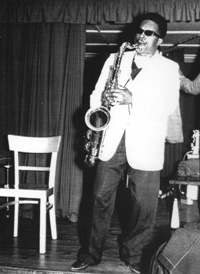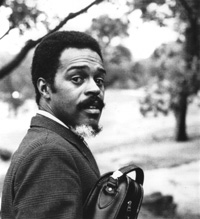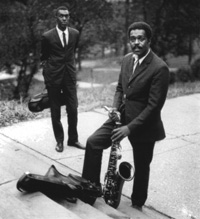| |
Albert
Ayler : Holy Ghost
by Scott Hreha & Matthew Sumera
November 2004
 |
|
Albert Ayler, Paris 1960
(© Ralph Sgrillo)
|
According to Amiri Baraka, Albert Ayler's favorite rhetorical barb
was, "You think it's about you?"—a tactic that at once
challenged and disarmed its recipient, especially after Ayler confessed
that it wasn't about him either. So who (or what) was it about then?
No analysis of Ayler's music will ever trivialize the importance of
religion as a primary influence on both his philosophy and his compositional/improvisational
devices; at certain points in his career, interviews with and published
writings by Ayler directly assert that he was little more than a mortal
conduit for the voice of God, to an oftentimes troubling extent. But
if there is any question as to whether or not it was indeed all about
a higher power in the extemporaneous moments in which Ayler so often
musically lived, Revenant's new addition to the saxophonist's legacy
does little to dispel the myths surrounding Ayler's life. Billed as
"the first comprehensive attempt to construct a monument in sound
to Albert Ayler", what is perhaps most interesting about the
Revenant set is the construction itself. For presumably by now, Ayler's
music is strong enough to stand alone.
If the name chosen for the package—a play on Ayler's famous permutation
of the Christian trinity that cast Coltrane as the Father, Pharoah
Sanders as the Son, and himself as the Holy Ghost—isn't the most
obvious tip-off that Ayler's mystique is of principal importance in
this (re)telling of the story, then the presentation itself closes
the deal. There's good reason why Revenant has won awards for similarly
extravagant undertakings; without getting too far into a table of
contents, let it suffice to say that this set is no exception to their
established standard of both aesthetic and partisan detail. But beyond
the gig poster reproductions and 200-page hardbound book, there is
a sort of contrived shamanism at work in the pressed dogwood flower
and plastic-molded "spirit box" that reflects a materialistic
iconography entirely disconnected from the presumed sanctity of Ayler's
musical message.
As Ben Ratliff, writing in the New York Times, has already
commented, the book's essays are little more than pat retellings of
the now mythic Ayler story—a life spent as a misunderstood, precocious,
and later anarchistic/visionary artist. Val Wilmer's piece is simply
an updated version of her As Serious As Your Life chapter;
Amiri Baraka's solipsistic essay is a rehashing of his Black Music-era
writings, lacking a bit of the vitriol but also, unfortunately, most
of the poetics; and Marc Chaloin's meticulously researched reconstruction
of Ayler's post-Army, pre-Spiritual Unity time boasts another
handful of primary sources to reinforce the tale. While there is some
merit in having these materials compiled, there is little new here
and even less that helps clear up the polemics and pseudo-religiosity
continuously surrounding Ayler. Project Supervisor Ben Young's annotations,
on the other hand, contribute invaluable insight to the existing musicological
analysis regarding Ayler and it's appropriate and compelling that
his contributions comprise roughly half of the book's content. In
many ways, Young is the unsung hero of this entire endeavor.
 |
|
Albert Ayler, Harlem 1966
(© Val Wilmer)
|
The audio interviews with Ayler himself—found on discs eight
and nine of the set—make up for some of the book's obfuscations
by providing glimpses both brief and exhaustive into Ayler's disposition
and worldview at different points in his career. The 1964 and 1966
interviews in Copenhagen present flip sides of Ayler's state of mind,
practically bookending the period of his most fertile musical development.
In 1964, Ayler sounds upbeat and optimistic on the eve of returning
to the US, confident that he will reconvene his group with Peacock
and Murray and insistent that his music will soon be accepted as a
legitimate progression of jazz. 1966 finds him more resigned and vague
in tone, wanting to clarify the fact that his music is not about protest
but rather a message of peace.
A July 27, 1970 interview with Daniel Caux is conducted with a calmer,
more reflective Ayler who largely dwells on autobiography; Val Wilmer's
essay in his own words, so to speak. He does add some fuel to the
long-debated fire surrounding his "commercial" turn with New Grass
and signing with Impulse! Records by stating that producer Bob Thiele
"told" him he had to sing. He doesn't seem all that bitter
about it, however, rather sounding pleased to finally be able to make
significant money as an artist (of course, this being Free Jazz we're
talking about, significant is certainly a relative term.) Ayler is
revealing through his reticence to a question about the connections
between his music and the Black Power/Black Arts movement, distancing
himself from Baraka and coolly dismissing Larry Neal's scathing review
of New Grass in The Cricket—in light of the man's
own words, then, it's interesting that Baraka would be included at
all in Holy Ghost, much less as a featured contributor. The
box's fundamentally Afrocentric design elements also seem suspect.
The interview with Kiyoshi Koyama, conducted two days earlier in Saint-Paul-de-Vence,
is easily the set's most priceless non-musical treasure. More conversational
than Q&A in tone, Ayler speaks in depth on some issues very close
at hand during that late stage of his life: His settling down with
companion Mary Maria in Brooklyn and the growing infrequency of his
trips to the East Village, and his allusion to the fact that his brother
Donald had been staying in Cleveland to take care of their ailing
mother are just two examples of the conversation's loose vibe. The
candid setting even lets Ayler reveal a rare sense of artistic conceit,
whether implying that Sonny Rollins would be jealous of the strength
of Ayler's tenor tone (and presumably, few wouldn't be), or telling
an interrupting Allen Blairman that he had better keep the intensity
level high at that evening's concert because Ayler was "gonna
be vibratin' that plastic ceiling off".
Koyama's interview also provides greater insight into the Impulse!
era than has previously been available; as Ben Young outlines in his
discussion of the New Grass outtakes, the interviews and the
music work in tandem to give a palpable sense of closure to that unresolved
aspect of Ayler's career.
 |
|
(l to r) Donald Ayler & Albert Ayler, Harlem
1966
(© Val Wilmer)
|
As to the music presented, for the Ayler fan it is what one would
expect: A series of striking performances (bootleg quality, mostly)
ranging from the European days through the early trio with Peacock
and Murray (still the most compelling music of his career), to the
quartet with Cherry, through to the Michel Sampson era, and ending
in Saint-Paul-de-Vence. Notable side-performances include a track
with Cecil Taylor (a nice companion to Revenant's masterpiece release
of Taylor's Café Monmartre recordings), a rather unfocused
reading of "Upper and Lower Egypt" with the Pharoah Sanders
Ensemble, and an absolutely paint-peeling Don Ayler Sextet, which
turns out to be the real revelation of the entire box, sounding like
a cross between a bullfight and a bloody insurrection. As a box set
devoted to a central figure of the jazz avant-garde, it is certainly
a valuable document to have. As a "monument in sound" to Ayler, it
is suspect for both what it presents as well as what it lacks.
On the presentation side, anyone coming to Ayler cold would unfortunately
come away with a rather skewed version of the man's music. What one
hears throughout the box are performances attended seemingly by three
people in the audience, all clapping uncomfortably, and recorded by
a gentleman in the back with a microphone hidden in his coat pocket.
Hard to make an argument about the centrality of Ayler without evidence
to support those statements—and make no mistake, this is a document
fundamentally about canon formation. Based upon the evidence that
Revenant presents, one might come away with the impression that Ayler
was a profoundly powerful saxophonist who was never heard and never
recorded. While he certainly was under-heard and under-recorded, Ayler
was also well known—enough at least according to Revenant to
be "THE catalytic force in defining the sound of the tenor in Free
Jazz." (It is this kind of hyperbole that unfortunately undermines
the set as a whole.) Compared to Beauty is a Rare Thing, Berlin
'88, or the recent Ayler Records set devoted to a similarly overlooked
genius, Jimmy Lyons, Holy Ghost somehow feels like it is underselling
the man. While all of the essential songs and tunes are here, for
better and for worse, Ayler's recorded output is inextricably linked
to the solvency of the ESP label. Due to, no doubt, contractual reasons,
those items are not in the set and it is consequently why Holy
Ghost can never be the definitive Ayler collection.
Luckily, Ayler's other recordings (including those on Impulse!) are
available, and the Revenant set helps immeasurably to flesh out the
story, as opposed to being the sole documentation. But it is the Revenant
argument that remains troubling: "Albert Ayler. Heard ABOUT more than
heard. But that's all about to change." This sort of overzealousness
cannot help Revenant's (or the Ayler estate's) cause and undoubtedly
will not sell any more copies of the set. While they managed to treat
Cecil Taylor with understated elegance, there is a sense that Ayler
somehow needs to be built up more than necessary. It is an odd feeling
that pervades the entire box and ultimately cannot help but mar Holy
Ghost. But perhaps it's only fitting that, even 35 years beyond
his time on the planet, Albert Ayler's music continues to have to
burn through both hype and hysteria, depending upon one's proclivities.
It is his sound, after all, that ushers forth from the discs as powerful
as ever, regardless of what constructs we might wish to place upon
it.
|
|
|
|
|

